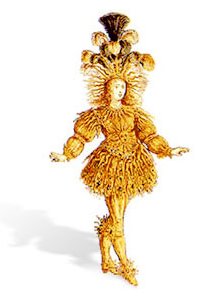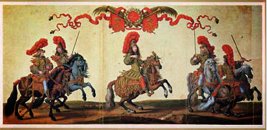. Blog reader Tana Bero wrote that she would like to know more about the sun motif.
Blog reader Tana Bero wrote that she would like to know more about the sun motif.
In 1653, young Louis XIV, then 15, danced in “Ballet of the Night”, costumed as Apollo the Sun god, wearing shoes with huge gilded sun buckles. It was an allegorical dance which portrayed the young King as the rising sun, dispelling darkness.
Almost ten years later (January 19, 1662), the King danced the same part, dressed as the sun, in an impromptu ballet performed chez Madame, his sister-in-law. A few weeks later of the same year (February 7, 1662), the Court gathered at the Tuileries palace to see “Hercules Amoureux.” The King danced in most scenes, several times appearing as the sun in a golden wig, the symbolism of the sun serving to represent the return of order.
 That summer, June 5-6, 1662. A tournament was held in front of the Tuileries. Again, Louis appears as the sun, but this time, for the first time, he used the emblem of the blazing sun on his coat-of-arms (instead of the fleur-de-lis), which won him the name le roi soleil. (His brother Philippe rode into the lists bearing a shield showing the moon eblazed with the motto, Uno sole minor“second only to the sun.”)
That summer, June 5-6, 1662. A tournament was held in front of the Tuileries. Again, Louis appears as the sun, but this time, for the first time, he used the emblem of the blazing sun on his coat-of-arms (instead of the fleur-de-lis), which won him the name le roi soleil. (His brother Philippe rode into the lists bearing a shield showing the moon eblazed with the motto, Uno sole minor“second only to the sun.”)
It was an apt symbol for Louis XIV, and from this point on, the sun emblem began to be used everywhere: on furniture, floors, carpets, wrought into gates and grilles, carved into marble vases and into door panels.


This is really fascinating, Sandra, an especially attractive topic today, at the winter solstice, when the day is at its shortest!
Mary